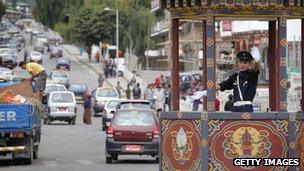Bhutan profile - Timeline
- Published
A chronology of key events:

Thimpu is Bhutan's political and economic centre
1907 - Ugyen Wangchuck is chosen as hereditary ruler.
1910 - Treaty signed with British giving them control over Bhutan's foreign relations.
1949 - Treaty signed with newly-independent India guaranteeing non-interference in Bhutan's internal affairs, but allowing Delhi influence over foreign relations.
1952 - Reformist monarch Jigme Dorji Wangchuck succeeds to throne.
1952 - National assembly established.
Modernisation
1958 - Slavery abolished. Other social reforms follow in subsequent years.
1959 - Several thousand refugees given asylum after Chinese annex Tibet.
1964, 1965 - Prime minister killed in dispute among competing political factions. Unsuccessful attempt to assassinate monarch.
1968 - First cabinet established.
1971 - Bhutan joins United Nations.
1972 - King Jigme Dorji Wangchuck dies and is succeeded by his son, Jigme Singye Wangchuck, who continues policy of cautious modernisation.
1974 - First foreign tourists allowed in.
Ethnic tension
1986 - New law granting citizenship on basis of length of residence in Bhutan.
1988 - Census leads to branding of many ethnic Nepalis as illegal immigrants. New measures adopted to enforce citizenship law. Government also introduces other measures to stress Tibetan-based Bhutanese culture, antagonising minority ethnic Nepali community.
1989 - Nepali ceases to be a language of instruction in schools.
1990 - Violent ethnic unrest and anti-government protests in southern Bhutan pressing for greater democracy and respect for Nepali rights. Bhutan People's Party begins campaign of violence. Thousands of ethnic Nepalis flee to Nepal.
Democracy and human rights
1992 - Leader of illegal Bhutan People's Party sentenced to life imprisonment.
1993 - Bhutan and Nepal try to resolve refugee problem.
1996 - Nepal demands all 80,000 or so refugees should be accepted back by Bhutan.
1997 - Amnesty International raises serious concerns over human rights situation in southern Bhutan.
1998 - King cedes some powers to national assembly, giving up role as head of government; cabinet now elected by assembly; famous "Tiger's Lair" Buddhist monastery damaged by fire.
1999 - Limited television and internet services allowed; several dozen political prisoners released.
2000 - First internet cafe opens in Thimphu; Bhutan hit by landslides following severe flooding in region, causing at least 200 deaths.
Refugee issue

Ethnic Nepali Bhutanese refugees live in UN-supervised camps in Nepal
2001 August - Bhutanese, Nepalese ministers meet to discuss the repatriation of Bhutanese refugees living in Nepal. Some 100,000 ethnic Nepalese say they were forced out of Bhutan in the 1980s and 1990s, alleging ethnic and political repression.
2002 January - Indian state of Assam says two rebel groups still have camps in Bhutan, despite Bhutan's deadline for them to leave the country by the end of 2001.
2003 December - Bhutanese soldiers fight Indian separatist rebels in an attempt to drive them from their bases in the south of the country.
2005 March - Proposed constitution is unveiled. It envisages a parliamentary democracy and will be adopted or rejected in a referendum.
Succession
2005 December - King Jigme Singye Wangchuck says he will abdicate in 2008, when democratic parliamentary elections are held. The crown prince will take over as monarch.
2006 June-August - Bhutanese refugees in Nepal demonstrate over several weeks to press for third-country resettlement.
2006 September - Preparations start in earnest for first ever elections in 2008. Officials begin training for the polls which will appoint a government to take over from the absolute monarchy.
2006 December - King Jigme Singye Wangchuck abdicates; Jigme Khesar Namgyel Wangchuck, the crown prince, assumes the throne. The former monarch had been expected to stay in power until 2008.
2007 February - Bhutan signs a landmark agreement with India which revises ties with its neighbour, giving Bhutan more say over its foreign and defence policies.
2007 April - Mock elections are staged to familiarise voters with the concept of parliamentary democracy ahead of planned polls in 2008.
2007 July - Prime Minister Khandu Wangchuck resigns so he can compete in elections planned for February and March 2008.
2008 January and February - A string of bomb blasts hits the country ahead of elections set for March 24. The attacks are blamed on groups fighting for the rights of ethnic Nepalis exiled in 1991.
2008 March - Pro-monarchy Bhutan Harmony Party wins 44 out of the 47 seats in the country's first parliamentary elections. Another pro-monarchy party wins the remaining seats.
2008 November - Jigme Khesar Namgyel Wangchuck is crowned king.
India alleges links between Assamese separatists and Bhutan dissident Druk National Congress.
2009 April - Huanglongbing virus wipes out much of orange crop. Oranges are an important export for Bhutan.
2011 October - King Jigme Khesar Namgyel Wangchuck marries 21-year-old student Jetsun Pema.
2013 July - Parliamentary elections: opposition People's Democratic Party wins 32 seats in the lower house, against the incumbent Druk Phuensum Tshogpa party's 15 seats.
2013 August - Prime Minister Tshering Tobgay says Bhutan's much lauded concept of Gross National Happiness is overused and masks the real problems facing the country like increasing debt, chronic unemployment, poverty and corruption.
2015 January - John Kerry becomes the first-ever US secretary of state to hold a cabinet-level meeting with a Bhutanese official when he meets Bhutanese Prime Minister Tshering Tobgay in India.
2016 February - King Jigme Khesar Namgyel Wangchuck and his wife, Queen Jetsun Pema announce the birth of Crown Prince Jigme Namgyal Wangchuck.
2017 June - Bhutan protests to China over its building of a road in disputed territory.